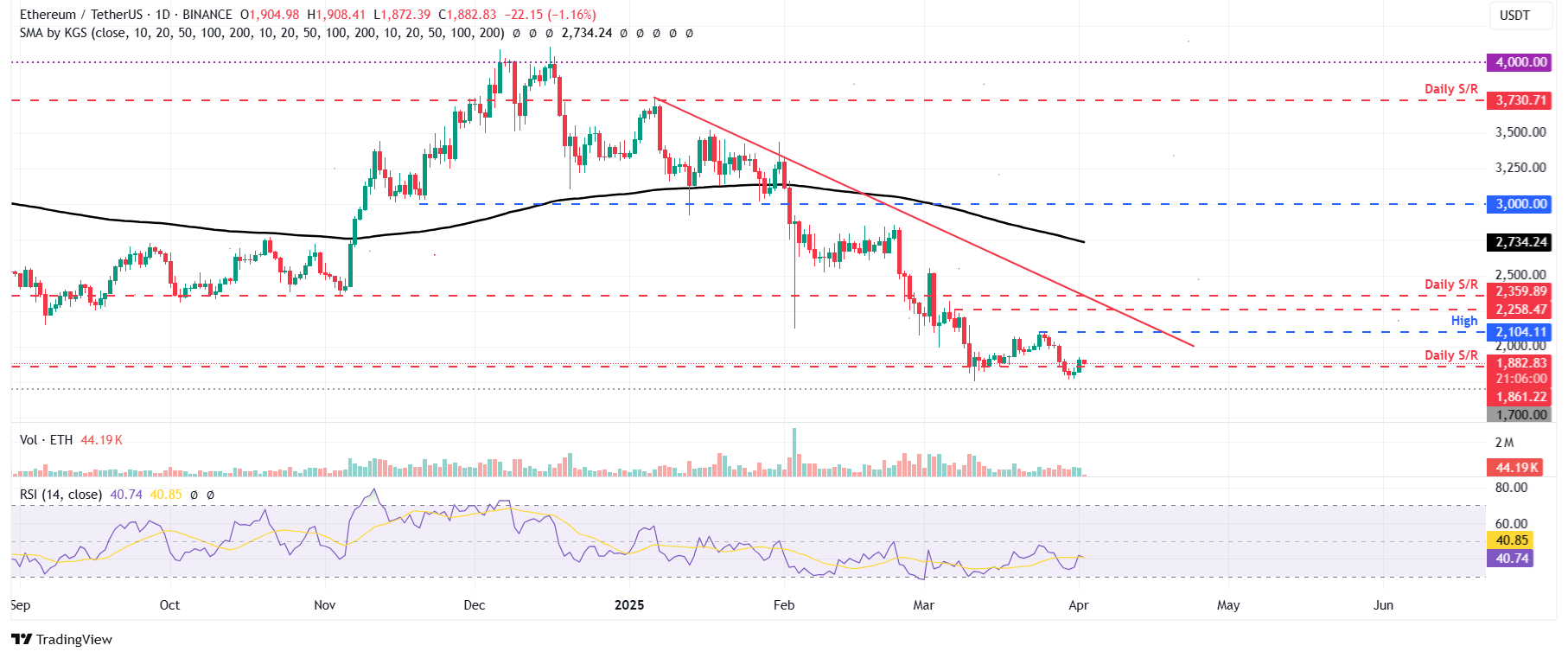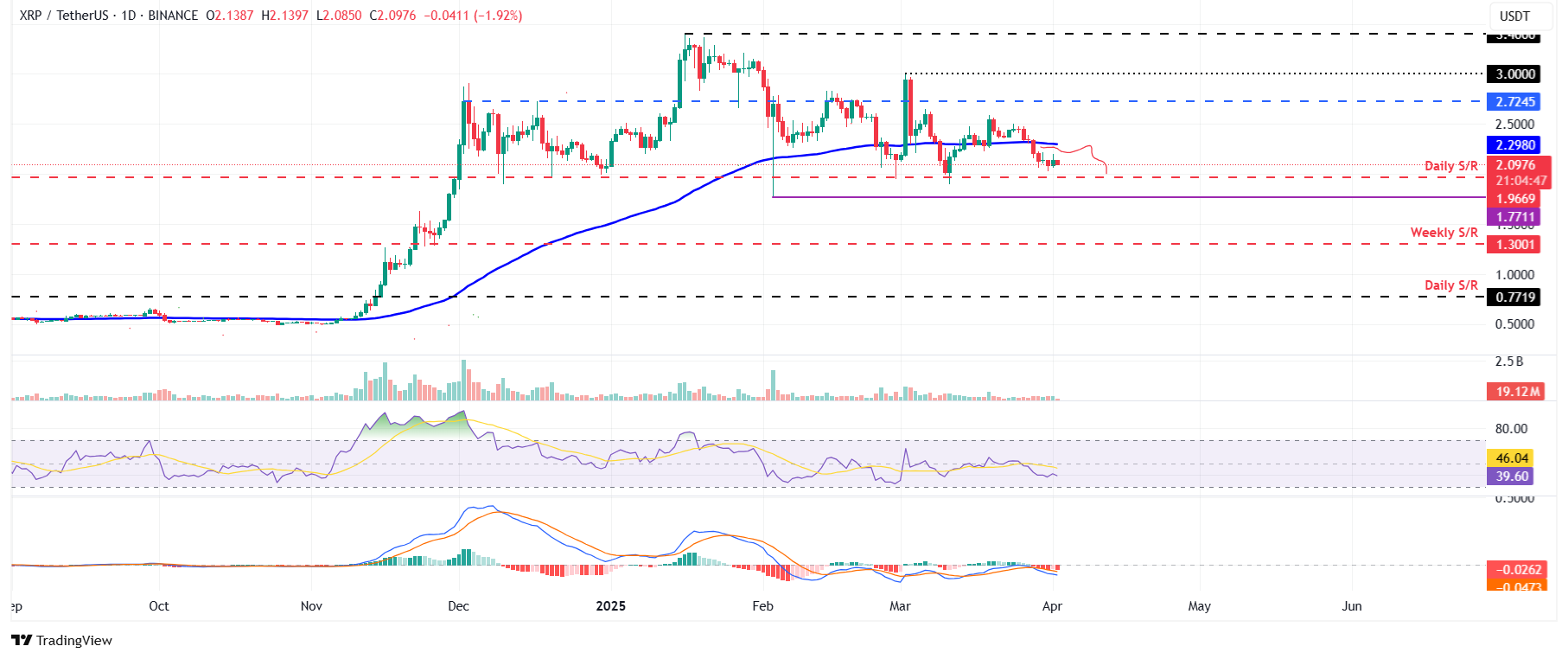- Bitcoin’s price experiences a slight setback near its important resistance level on Wednesday after a 3.16% recovery the day before.
- Ethereum has risen above its daily resistance at $1,861, signaling potential recovery ahead.
- XRP sees a decline below its 100-day EMA, suggesting a possible correction in the near future.
Bitcoin (BTC) is encountering a minor rejection at its $85,000 resistance level on Wednesday, following a 3.16% recovery the prior day. Ripple (XRP) trails Bitcoin as it dips below a critical threshold, pointing to weakness and the possibility of a correction. On the other hand, Ethereum’s (ETH) price has successfully surpassed its key resistance, indicating a potential for recovery. Traders should pay attention to the significant “Liberation Day” event on Wednesday, which may involve notable tariff announcements that could inject volatility into the cryptocurrency market given the implications of retaliatory tariffs.
Bitcoin shows signs of recovery while approaching significant resistance
Bitcoin’s price settled around $82,500 to kick off the week on Monday and gained 3.16% the following day. As of Wednesday, it is slightly retreating from its daily resistance level at $85,000—a level that coincides with both the 200-day EMA and a descending trendline, making it a pivotal resistance zone.
The Relative Strength Index (RSI) on the daily timeframe reads 47 and is trending downward after being rejected from its neutral point of 50, suggesting bearish momentum. Should the RSI continue to decrease, this could amplify bearish pressure, potentially leading to a significant drop in BTC’s value.
The Moving Average Convergence Divergence (MACD) lines are converging, reflecting uncertainty among traders.
If Bitcoin consistently faces rejection at its daily resistance of $85,000, it could extend its slide to re-test a support level at $78,258.
BTC/USDT daily chart
However, should Bitcoin manage to recover and close above the $85,000 resistance, it could push further towards the significant psychological mark of $90,000.
Ethereum may face a downturn if $1,861 support fails
Ethereum’s price dropped below its daily support of $1,861 last week, leading to a 9.88% decline. Yet, it managed a recovery of 4.05% at the start of this week, holding above the $1,861 mark until Tuesday. At this moment, it is slightly down, approaching its daily resistance level of $1,861 once again.
If ETH cannot sustain support around $1,861 and continues downwards, it might dip further to test the critical psychological level of $1,700.
The RSI on the daily chart shows a reading of 40, below its neutral area of 50, indicating bearish momentum similar to Bitcoin and XRP.

ETH/USDT daily chart
Conversely, if ETH manages to find support around the $1,861 threshold and continues its upward movement, it could see a recovery towards its March 24 peak at $2,104.
XRP shows signs of weakness after closing under its 100-day EMA
XRP’s price fell below its 100-day EMA at $2.30 last week, resulting in a 12.40% decrease. Over the last two days, it has steadied around the $2.14 level. As of Wednesday, it is trading slightly down around $2.09.
Should XRP continue its downward correction, it might decline further to test the next support level at $1.96.
The RSI on the daily chart reads 39, also below the neutral level of 50, reflecting bearish momentum similar to Bitcoin and Ethereum.

XRP/USDT daily chart
However, if XRP manages to recover, it could shift upward towards the previously breached 100-day EMA at $2.30.
FAQs about Bitcoin, Altcoins, and Stablecoins
Bitcoin is the leading cryptocurrency by market capitalization and is intended to function as a form of currency. This digital currency operates independently of any single person, group, or organization, thereby eliminating the need for intermediary entities in transactions.
Altcoins encompass all cryptocurrencies other than Bitcoin, although some may classify Ethereum separately due to its prominence among these assets. If that is the case, Litecoin is regarded as the first altcoin, having forked from Bitcoin’s protocol and presenting itself as an “enhanced” version.
Stablecoins are cryptocurrencies designed to maintain a stable value, typically backed by an asset reserve. They achieve stability by pegging their value to a financial instrument or commodity, such as the US Dollar (USD), with their supply regulated by algorithms or market forces. The primary aim of stablecoins is to facilitate easier trading and investing in the cryptocurrency space while allowing for value preservation given the overall volatility in crypto markets.
Bitcoin dominance refers to Bitcoin’s market capitalization relative to the total market capitalization of all cryptocurrencies. It indicates the level of investor interest in Bitcoin. Higher Bitcoin dominance is typically observed before and during a bullish trend when investors gravitate towards established, stable cryptocurrencies like Bitcoin. A decrease in Bitcoin dominance often suggests a shift of capital towards altcoins as investors seek greater returns, often resulting in significant rallies among alternative cryptocurrencies.
